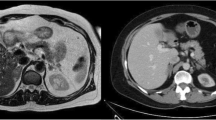Abstract
Background
Bilateral laparoscopic adrenalectomy (BLA) is an effective therapy for the management of persistent hypercortisolism in patients after failed transphenoidal pituitary tumor resection for Cushing’s disease. Extracortical adrenal tissue has been identified as a source of persistent hypercortisolism and, if not resected along with both adrenal glands, may lead to treatment failure. We report a reliable and reproducible technique called the “psoas sign” for BLA in patients with Cushing’s disease which reduces the likelihood of retained extra-adrenal cortical rests and may reduce intraoperative complications.
Methods
A 16-year retrospective review of all consecutive patients who underwent transabdominal BLA at a single tertiary care center was performed. All patients underwent BLA utilizing the psoas sign technique and all procedures were performed replicating these predetermined surgical steps: (1) Identification of the inferior pole of the gland. (2) Identification of the inferior aspect of the adreno-caval groove on the right or the adrenal vein/renal vein confluence on the left. (3) Division of the adrenal vein. (4) Dissection and removal of the adrenal gland with clearance of all retroperitoneal fat overlying the psoas muscle.
Results
Between October 1996 and December 2012, 92 patients underwent BLA for refractory Cushing’s disease. Patients were predominantly female (90 %) with a median age of 40 years (17–71). There were 3 intraoperative complications (3.2 %), 2 conversions (2.2 %), and 1 death (1.09 %). Four patients were identified as having extracortical rests of adrenal tissue within the retroperitoneal fat (4.3 %). Mean operative time was 272 min (±79.25, n = 68) and median estimated blood loss was 50 mL (10–800 mL).
Conclusions
The psoas sign technique provides a clear view of the adrenal fossa and facilitates careful dissection of the anatomic planes around the adrenal gland. This technique is feasible, reproducible and in our experience allows for safe removal of both adrenal glands and all surrounding extracortical adrenal tissue.





Similar content being viewed by others
References
Tritos NA, Biller BM, Swearingen B (2011) Medscape. Management of Cushing disease. Nat Rev Endocrinol 7(5):279–289
Smith PW, Turza KC, Carter CO, Vance ML, Laws ER, Hanks JB (2009) Bilateral adrenalectomy for refractory Cushing disease: A safe and definitive therapy. J Am Coll Surg 208(6):1059–1064
Vargas HI, Kavoussi LR, Bartlett DL et al (1997) Laparoscopic adrenalectomy: a new standard of care. Urology 49(5):673–678
Jeschke K, Janetschek G, Peschel R, Schellander L, Bartsch G, Henning K (2003) Laparoscopic partial adrenalectomy in patients with aldosterone-producing adenomas: indications, technique, and results. Urology 61(1):69–72
Janetschek G, Lhotta K, Gasser R, Finkenstedt G, Jaschke W, Bartsch G (1997) Adrenal-sparing laparoscopic surgery for aldosterone-producing adenoma. J Endourol 11(2):145–148
Bookstein J (1983) The roles of angiography in adrenal disease. Abram’s angiography, 3rd edn. Little Brown, Boston, pp 1395–1424
Schechter DC (1968) Aberrant adrenal tissue. Ann Surg 167(3):421–426
Barwick TD, Malhotra A, Webb JA, Savage MO, Reznek RH (2005) Embryology of the adrenal glands and its relevance to diagnostic imaging. Clin Radiol 60(9):953–959
Rutherford JC, Gordon RD, Stowasser M, Tunny TJ, Klemm SA (1995) Laparoscopic adrenalectomy for adrenal tumours causing hypertension and for ‘incidentalomas’ of the adrenal on computerized tomography scanning. Clin Exp Pharmacol Physiol 22(6–7):490–492
Go H, Takeda M, Takahashi H et al (1993) Laparoscopic adrenalectomy for primary aldosteronism: a new operative method. J Laparoendosc Surg 3(5):455–459
Disclosures
Drs. Erin W. Gilbert, Vincent L. Harrison, and Brett C. Sheppard have no conflicts of interest or financial ties to disclose.
Author information
Authors and Affiliations
Corresponding author
Rights and permissions
About this article
Cite this article
Gilbert, E.W., Harrison, V.L. & Sheppard, B.C. The adrenal psoas sign: surgical outcomes following a simple technique to maximize removal of extracortical adrenal tissue during bilateral laparoscopic adrenalectomy. Surg Endosc 28, 2666–2670 (2014). https://doi.org/10.1007/s00464-014-3524-8
Received:
Accepted:
Published:
Issue Date:
DOI: https://doi.org/10.1007/s00464-014-3524-8




